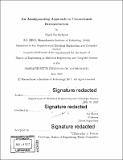An amalgamating approach to connectomic reconstruction
Author(s)
Saribekyan, Hayk.
Download1017490116-MIT.pdf (5.517Mb)
Other Contributors
Massachusetts Institute of Technology. Department of Electrical Engineering and Computer Science.
Advisor
Nir Shavit.
Terms of use
Metadata
Show full item recordAbstract
The reconstruction of neurons from connectomics image stacks presents a challenging problem in computer vision. The neuronal objects and their shapes, unlike the objects in natural images, vary greatly in shape and size. Recent methods for reconstruction of individual objects like the flood-filling networks and mask-extend showed a possibility of a new direction in the field. By using a CNN to track a single continuously changing object in the stack, much like a human tracer would do, they achieve a better accuracy than previous agglomeration algorithms. Unfortunately, these methods are costly for dense reconstruction of neurons in a volume as the number of CNN computations increases linearly in the number of objects. The cross classification clustering algorithm generalizes these accurate methods and tracks all objects in the volume at the same time. It uses only a logarithmic number of fully convolutional CNN passes by reformulating the complex clustering problem of unknown number of objects into a series of independent classifications on image pixels. These classifications together uniquely define the labels in each slice of the volume. We present a pipeline based on cross classification clustering that delivers improved reconstruction accuracy. A significant contribution of our pipeline is its streaming nature which will allow very large datasets to be segmented without storing them.
Description
Thesis: M. Eng., Massachusetts Institute of Technology, Department of Electrical Engineering and Computer Science, 2017 Cataloged from PDF version of thesis. Includes bibliographical references (pages 57-60).
Date issued
2017Department
Massachusetts Institute of Technology. Department of Electrical Engineering and Computer SciencePublisher
Massachusetts Institute of Technology
Keywords
Electrical Engineering and Computer Science.